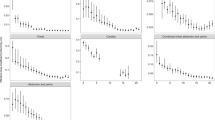Abstract
This paper discusses the merits and weaknesses of the standard terms that have been developed to quantify CT dose: CT dose indices (CTDI), dose length product (DLP) and effective dose. The difference between the measured CTDIvol and the CTDIvol displayed on the CT scanner illustrates a clinical dilemma. Displayed CTDIvol represents the radiation dose delivered to a plastic phantom, which is significantly different from the dose delivered to the patient, depending on the size of the patient. Although effective dose is simple to calculate for an individual patient, it was never intended for this purpose. The need for a simple, appropriate method to estimate pediatric patient doses led to the development of the size-specific dose estimate (SSDE), the newest CT dose index. Here I compare SSDE and its merits to the use of effective dose to estimate patient dose. The discussion concludes with a few sample calculations and basic clinical applications of SSDE to better quantify pediatric patient dose from CT scans.













Similar content being viewed by others
References
Brody AS, Frush DP, Huda W et al (2007) Radiation risk to children from computed tomography. Pediatrics 120:677–682
Shrimpton PC, Edyvean S (1998) CT scanner dosimetry. Br J Radiol 71:1–3
Shrimpton PC, Hart D, Hillier MC et al (1991) Survey of CT practice in the UK. Part 1: aspects of examination frequency and quality assurance. National Radiological Protection Board, Chilton
Brenner DJ, Hall EJ (2007) Computed tomography — an increasing source of radiation exposure. New Engl J Med 357:2277–2284
Larson DB, Johnson LW, Schnell BM et al (2011) Rising use of CT in child visits to the emergency department in the United States, 1995–2008. Radiology 259:793–801
Brenner D, Elliston C, Hall E et al (2001) Estimated risks of radiation-induced fatal cancer from pediatric CT. AJR Am J Roentgenol 176:289–296
Frush DP, Donnelly LF, Rosen NS (2003) Computed tomography and radiation risks: what pediatric health care providers should know. Pediatrics 112:951–957
Mathews JD, Forsythe AV, Brady Z et al (2013) Cancer risk in 680,000 people exposed to computed tomography scans in childhood or adolescence: data linkage study of 11 million Australians. Br Med J 346:f2360
Hall EJ (2002) Lessons we have learned from our children: cancer risks from diagnostic radiology. Pediatr Radiol 32:700–706
Berdon WE, Slovis TL (2002) Where we are since ALARA and the series of articles on CT dose in children and risk of long-term cancers: what has changed? Pediatr Radiol 32:699
Slovis TL (2002) The ALARA concept in pediatric CT: myth or reality? Radiology 223:5–6
Shope TB, Gagne RM, Johnson GC (1981) A method for describing the doses delivered by transmission X-ray computed tomography. Med Phys 8:488–495
Strauss KJ, Goske MJ, Frush DP et al (2009) Image Gently vendor summit: working together for better estimates of pediatric radiation dose from CT. AJR Am J Roentgenol 192:1169–1175
Boone JM, Strauss KJ, Cody DD et al (2011) Size-specific dose estimates (SSDE) in pediatric and adult body CT examinations. American Association of Physicists in Medicine, College Park, MD
Huda W, Ogden KM (2008) Computing effective doses to pediatric patients undergoing body CT examinations. Pediatr Radiol 38:415–423
McCollough CH, Schueler BA (2000) Calculation of effective dose. Med Phys 27:828–837
Bushberg JT, Seibert JA, Leidholt EM et al (2012) The essential physics of medical imaging. Lippincott, Williams & Wilkins, Philadelphia, p 1030
McNitt-Gray MF (2002) AAPM/RSNA physics tutorial for residents: topics in CT. Radiation dose in CT. Radiographics 22:1541–1553
Commission IE (2002) Medical electrical equipment, part 2–44. Particular requirements for the safetey of X-ray equipment for computed tomography. In: Commission IE (ed) Medical electrical equipment. International Electrotechnical Commission, Geneva
Jessen K, Panzer W, Shrimpton PC et al (2000) European guidelines on quality criteria for computed tomography. Publications Office of the European. Union, Luxembourg
Leitz W, Axelsson B, Szendro G (1995) Computed tomography dose assessment: a practical approach. Radiat Prot Dosimetry 157:377–380
International Commission on Radiological Protection (1991) 1990 recommendations of the International Commission on Radiological Protection. Ann ICRP 21:1–201, HYPERLINK http://www.ncbi.nlm.nih.gov/pubmed/2053748
Deak PD, Smal Y, Kalender WA (2010) Multisection CT protocols: sex- and age-specific conversion factors used to determine effective dose from dose-length product. Radiology 257:158–166
Dixon RL (2003) A new look at CT dose measurement: beyond CTDI. Med Phys 30:1272–1280
Dixon RL (2006) Restructuring CT dosimetry — a realistic strategy for the future requiem for the pencil chamber. Med Phys 33:3973–3976
Boone JM (2007) The trouble with CTD100. Med Phys 34:1364–1371
Kleinman PL, Strauss KJ, Zurakowski D et al (2010) Patient size measured on CT images as a function of age at a tertiary care children’s hospital. AJR Am J Roentgenol 194:1611–1619
Martin CJ (2007) Effective dose: how should it be applied to medical exposures? Br J Radiol 80:639–647
McCollough CH, Christner JA, Kofler JM (2010) How effective is effective dose as a predictor of radiation risk? AJR Am J Roentgenol 194:890–896
Goske MJ, Callahan M, Frush DP et al (2012) The Image Gently campaign: championing radiation protection for children through awareness, educational resources and advocacy. In: Tack D, Kalra MK, Gevenois PA (eds) Radiation dose from multidetector CT. Springer-Verlag, Berlin
Strauss KJ, Goske MJ (2011) Estimated pediatric radiation dose during CT. Pediatr Radiol 41:472–482
Conflicts of interest
Keith Strauss provides paid consulting services to Philips Healthcare (Best, The Netherlands) upon request.
Author information
Authors and Affiliations
Corresponding author
Rights and permissions
About this article
Cite this article
Strauss, K.J. Dose indices: everybody wants a number. Pediatr Radiol 44 (Suppl 3), 450–459 (2014). https://doi.org/10.1007/s00247-014-3104-z
Received:
Revised:
Accepted:
Published:
Issue Date:
DOI: https://doi.org/10.1007/s00247-014-3104-z




